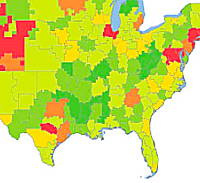Tech
Forbidden fruit: Is the Bible Belt unfriendly to Apple?
As one might expect, a recent report on Apple's U.S. market penetration shows its top 10 markets in Apple's home town, in major metro areas and surprisingly in Las Vegas. However, a look at the bottom 10 reveals that Apple products are sparse in parts of the Bible Belt.


2. Boston, MA: Almost one-in-three adults in the Boston DMA (31.3 percent) own or use an iPod, iPhone or Mac computer making area residents 45 percent more likely than average to be Mac maniacs. And with 11 Apple stores located within the Boston DMA, residents never have to go far for their Apple fix. 3. San Diego, CA: San Diego-area residents are 42 percent more likely than the average American to be toting around an iPod, chatting on an iPhone or computing on a Mac. In fact, 31.8 percent of the San Diego DMA’s 2.2 million adults are admitted Mac users. 4. New York, NY: Anyone can tell you that iPhones are about as common in New York City as taxis, which supports the fact that there are roughly 4.9 million Mac-users in the New York DMA. Of the almost 16 million adults in the area, 30.4 percent use either an iPod, iPhone or Mac computer. 5. Washington, D.C.: Residents of our nation’s capitol can agree on at least one thing: their love for Apple. D.C.-area residents are 39 percent more likely than average to be found listening to an iPod, chatting on an iPhone or tapping away on a Mac computer.Also in the Top 10 are several west coast cities, such as San Diego and Santa Barbara, Chicago (a region with a lot of printing history), Denver and Las Vegas. I took a look at the bottom of the list and found that interesting reading as well. Here are the names of the bottom 10 areas with a population greater than 500K (Number 1 is the lowest): 1. Charleston-Huntington, WV: Only 11 percent of the 912,277 adult residents use an Apple product. Ranking 197/206. 2. Tri-Cities, TN-VA: Apple penetration is 11.5 percent. Ranking 196/206. 3. Shreveport, LA: PCs are popular here with only 12.3 percent Apple users. Ranking 190/206. 4. Tyler-Longview (Lufkin & Nacogdoches), TX: Only 12.9 percent of the 537,418 population use Apple. Ranking 185/206. 5. Johnstown-Altoona, PA: Lucky 13 percent. Ranking 184/206. 6. Springfield, MO: Of a population of 802,021 only 106,705 use Apple, 13.3 percent. Ranking 180/206. 7. Myrtle Beach-Florence, SC: Apple penetration is 13.7 percent. Ranking 177/206. 8. Wilkes Barre-Scranton, PA: Apple penetration is 13.9 percent. Ranking 173/206. 9. Little Rock-Pine Bluff, AR: Apple penetration is 13.9 percent. Ranking 172/206. 10. 163 Jackson, MS: Apple penetration is 14.7 percent. Ranking 163/206. I noticed that many of these Apple-unfriendly regions can be found in the Bible Belt. Perhaps there's a fallout from the Western European depiction of the biblical "forbidden fruit" as being an apple. [“But as for the tree of knowledge of good and bad, you must not eat of it; for as soon as you eat of it, you shall die.” (Genesis 2:17 The Jewish Publication Society translation)] On the ifo Apple Store blog, Gary Allen also pointed out that Apple has placed stores in some not-so-loyal regions, including Tulsa, which is at the bottom of the list.
Beyond the top 10 loyal regions, there are several other high-ranked regions without an Apple store, including Baltimore (Md., #13), Charlottesville (Virg., #16), Boise (Idaho, #25), Lafayette (Ind., #36) and El Paso (Tex., #46). Baltimore is served by two stores in the far suburbs, while Lafayette and Boise are home to universities. Tipsters say a store will open in Boise this fall. But the other cities listed above have never been spotted on any listing of possbile store locations. How far down the loyal list of 206 metro areas did Apple dip to locate an Apple store? Tulsa (Okla.) has the lowest percentage of Apple users in the study, just 15.7 percent, and it’s ranked #145. Apple opened a store at the Woodland Hills mall in June 2007.